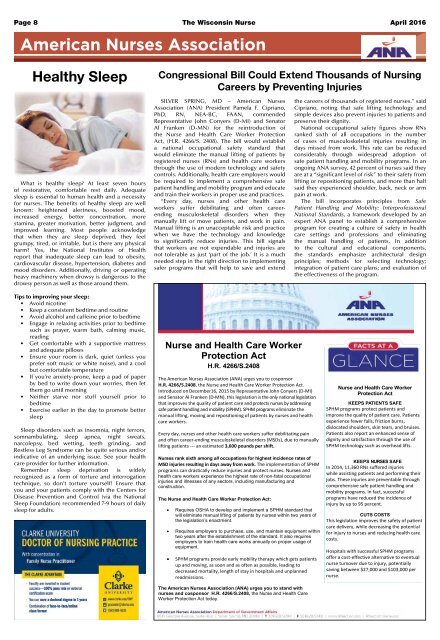The Wisconsin Nurse - April 2016
Create successful ePaper yourself
Turn your PDF publications into a flip-book with our unique Google optimized e-Paper software.
Page 8 <strong>The</strong> <strong>Wisconsin</strong> <strong>Nurse</strong> <strong>April</strong> <strong>2016</strong><br />
American <strong>Nurse</strong>s Association<br />
Healthy Sleep<br />
Congressional Bill Could Extend Thousands of Nursing<br />
Careers by Preventing Injuries<br />
What is healthy sleep? At least seven hours<br />
of restorative, comfortable rest daily. Adequate<br />
sleep is essential to human health and a necessity<br />
for nurses. <strong>The</strong> benefits of healthy sleep are well<br />
known: heightened alertness, boosted mood,<br />
increased energy, better concentration, more<br />
stamina, greater motivation, better judgment, and<br />
improved learning. Most people acknowledge<br />
that when they are sleep deprived, they feel<br />
grumpy, tired, or irritable, but is there any physical<br />
harm? Yes, the National Institutes of Health<br />
report that inadequate sleep can lead to obesity,<br />
cardiovascular disease, hypertension, diabetes and<br />
mood disorders. Additionally, driving or operating<br />
heavy machinery when drowsy is dangerous to the<br />
drowsy person as well as those around them.<br />
Tips to improving your sleep:<br />
• Avoid nicotine<br />
• Keep a consistent bedtime and routine<br />
• Avoid alcohol and caffeine prior to bedtime<br />
• Engage in relaxing activities prior to bedtime<br />
such as prayer, warm bath, calming music,<br />
reading<br />
• Get comfortable with a supportive mattress<br />
and adequate pillows<br />
• Ensure your room is dark, quiet (unless you<br />
prefer soft music or white noise), and a cool<br />
but comfortable temperature<br />
• If you’re anxiety-prone, keep a pad of paper<br />
by bed to write down your worries, then let<br />
them go until morning<br />
• Neither starve nor stuff yourself prior to<br />
bedtime<br />
• Exercise earlier in the day to promote better<br />
sleep<br />
Sleep disorders such as insomnia, night terrors,<br />
somnambulating, sleep apnea, night sweats,<br />
narcolepsy, bed wetting, teeth grinding, and<br />
Restless Leg Syndrome can be quite serious and/or<br />
indicative of an underlying issue. See your health<br />
care provider for further information.<br />
Remember sleep deprivation is widely<br />
recognized as a form of torture and interrogation<br />
technique, so don’t torture yourself! Ensure that<br />
you and your patients comply with the Centers for<br />
Disease Prevention and Control (via the National<br />
Sleep Foundation) recommended 7-9 hours of daily<br />
sleep for adults.<br />
SILVER SPRING, MD – American <strong>Nurse</strong>s<br />
Association (ANA) President Pamela F. Cipriano,<br />
PhD, RN, NEA-BC, FAAN, commended<br />
Representative John Conyers (D-MI) and Senator<br />
Al Franken (D-MN) for the reintroduction of<br />
the <strong>Nurse</strong> and Health Care Worker Protection<br />
Act, (H.R. 4266/S. 2408). <strong>The</strong> bill would establish<br />
a national occupational safety standard that<br />
would eliminate the manual lifting of patients by<br />
registered nurses (RNs) and health care workers<br />
through the use of modern technology and safety<br />
controls. Additionally, health care employers would<br />
be required to implement a comprehensive safe<br />
patient handling and mobility program and educate<br />
and train their workers in proper use and practices.<br />
“Every day, nurses and other health care<br />
workers suffer debilitating and often careerending<br />
musculoskeletal disorders when they<br />
manually lift or move patients, and work in pain.<br />
Manual lifting is an unacceptable risk and practice<br />
when we have the technology and knowledge<br />
to significantly reduce injuries. This bill signals<br />
that workers are not expendable and injuries are<br />
not tolerable as just ‘part of the job.’ It is a much<br />
needed step in the right direction to implementing<br />
safer programs that will help to save and extend<br />
the careers of thousands of registered nurses.” said<br />
Cipriano, noting that safe lifting technology and<br />
simple devices also prevent injuries to patients and<br />
preserve their dignity.<br />
National occupational safety figures show RNs<br />
ranked sixth of all occupations in the number<br />
of cases of musculoskeletal injuries resulting in<br />
days missed from work. This rate can be reduced<br />
considerably through widespread adoption of<br />
safe patient handling and mobility programs. In an<br />
ongoing ANA survey, 42 percent of nurses said they<br />
are at a “significant level of risk” to their safety from<br />
lifting or repositioning patients, and more than half<br />
said they experienced shoulder, back, neck or arm<br />
pain at work.<br />
<strong>The</strong> bill incorporates principles from Safe<br />
Patient Handling and Mobility: Interprofessional<br />
National Standards, a framework developed by an<br />
expert ANA panel to establish a comprehensive<br />
program for creating a culture of safety in health<br />
care settings and professions and eliminating<br />
the manual handling of patients. In addition<br />
to the cultural and educational components,<br />
the standards emphasize architectural design<br />
principles; methods for selecting technology;<br />
integration of patient care plans; and evaluation of<br />
the effectiveness of the program.

















